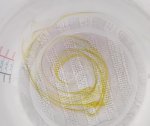Hi,
I have just refilled my pool with borehole water. This is the second time I have (re)filled.
My water holds iron, about 0.05 mg/L.
When I added chlorine, the water turned very brown. The chlorine apparently turns the FE in the water into rust particles.
My cartridge filter removes the rust particles. I have already cleaned the filter right after refilling and 3 days after that.
The filter was very brown, but it washed off reasonably easy. The water is now very crystal clear.
This happened now and also with the other filling, 2 years ago.
At the moment, I am lowering my TA. See other post.
But I have noticed something strange. When I use OTO drops to measure TC, I found that the water turns blueish at a specific concentration of the OTO.
For example, 1 drop in the test tube may turn the water yellow, the 2nd drop turns it blue/brown, and the 3th will turn it yellow again.
This is also visible when you fill a 1L can with water, rotate the water a bit, and then put in a drop of OTO. The OTO will turn the water yellow, but you also see some darker strands of water. See picture.
I have the idea that the effect is slowly getting weaker, but it is still very well visible.
At the moment I am using trichlor tablets, so I will build up some CYA. When there is enough CYA, I will use my SWG.
The water is crystal clear. If I put a drop of OTO in fresh borehole water, nothing shows up. If I then add a little chlorine, the effect is there again.
I have not seen this before, so it looks like it slowly goes away (?)
Does anyone have an idea what may cause this.
It worries me because I am afraid it may not be good for the SWG.
Thanks!
I have just refilled my pool with borehole water. This is the second time I have (re)filled.
My water holds iron, about 0.05 mg/L.
When I added chlorine, the water turned very brown. The chlorine apparently turns the FE in the water into rust particles.
My cartridge filter removes the rust particles. I have already cleaned the filter right after refilling and 3 days after that.
The filter was very brown, but it washed off reasonably easy. The water is now very crystal clear.
This happened now and also with the other filling, 2 years ago.
At the moment, I am lowering my TA. See other post.
But I have noticed something strange. When I use OTO drops to measure TC, I found that the water turns blueish at a specific concentration of the OTO.
For example, 1 drop in the test tube may turn the water yellow, the 2nd drop turns it blue/brown, and the 3th will turn it yellow again.
This is also visible when you fill a 1L can with water, rotate the water a bit, and then put in a drop of OTO. The OTO will turn the water yellow, but you also see some darker strands of water. See picture.
I have the idea that the effect is slowly getting weaker, but it is still very well visible.
At the moment I am using trichlor tablets, so I will build up some CYA. When there is enough CYA, I will use my SWG.
The water is crystal clear. If I put a drop of OTO in fresh borehole water, nothing shows up. If I then add a little chlorine, the effect is there again.
I have not seen this before, so it looks like it slowly goes away (?)
Does anyone have an idea what may cause this.
It worries me because I am afraid it may not be good for the SWG.
Thanks!


